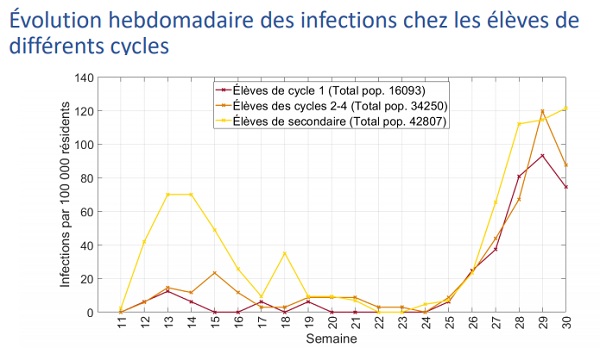
On Friday 14 August 2020, Luxembourg's Minister of Health, Paulette Lenert, and the Minister of National Education, Children and Youth, Claude Meisch, together with the experts Laetitia Huiart (Health Inspectorate of the Directorate of health) and Paul Wilmes (University of Luxembourg), presented details of a report on schools facing COVID-19 in Luxembourg.
Carried out by a multi-disciplinary team of scientists and educators, the study analyses the situation of infections and contaminations in schools across the country, as it developed following the resumption of classes from 4 May 2019, first in small groups, then in full classes. The report will help guide preparations for the start of the 2020/2021 school year, a start that should be under the sign of COVID-19 and adaptable protection measures.
The study focused on 93,150 pupils spread across the various educational establishments of the country (public, according to the national and international programme, private according to the national programme) and 11,667 teachers over the period from 9 March to 26 July 2020. It is based on the current state of scientific knowledge on COVID-19, statistical comparisons between the general population and school population in Luxembourg and the analysis of quarantine cases within the framework of contact tracing.
The findings
Minister Lenert underlined “From a public health point of view, this in-depth analysis shows that at this stage child-to-child transmission in schools is rare and has not been the main cause of SARS-CoV-2 infection in children. The data currently available suggests that if appropriate physical distancing and hygiene measures are applied, schools are not more risky propagation environments than other work or leisure settings with similar densities of people".
The study shoed that just 11.6% of transmission cases (49 in total) were traced to schools.
The main findings of the group of experts are as follows:
• Despite the presence of contagious people, the risk of intra-school transmission has so far been limited and insufficient to produce large clusters of cases.
• This low risk of intra-school transmission cannot be dissociated from the strict public health measures put in place (barrier gestures, separation of classes, wide access to tests, rapid isolation of cases, quarantine of contacts).
• As in other countries, the risk of complications and hospitalisations is low in young people.
• Since mid-June, the incidence among teachers has been similar or even slightly lower than that of the professionally active population.
• The increase in prevalence in the general population has led to an increase in positive people (pupils and teachers) present in the school environment (> 100 people since mid-June).
• Internationally, there is little data on the risk of transmission in schools and there is no consensus on the potential role of schools in transmitting COVID-19. However, schools do not appear to be a major propagation medium.
Outlook for the start of the school year
Minister Meisch recalled that the pandemic was very likely to last and that we have to learn to live with it, learn to teach and study with it. "The aim is to guarantee as much as possible the right to education and maximum security for pupils and teachers. We need clear rules so that schools can operate as normally as possible.”
The negative effects of a prolonged closure of schools both on students' learning and on their mental, emotional and social well-being, and therefore their future, must be put in relation to the risks associated with the disease, in the context of a policy of maintaining rigorous sanitary measures. All the more so since it is already the most disadvantaged students who suffer the most from distance from educational structures.
The start of the school year will therefore be marked by:
• Maximum attendance in class, while respecting the necessary health measures;
• A system of support measures for pupils who need it in order to avoid an increase in educational inequalities;
• Improving distance education for vulnerable students who cannot be physically present;
• The dissemination of health recommendations, developed by the Department of Health, to schools and educational structures, taking into account the different educational contexts and ages;
• Informing children and young people about hygiene rules, and parents on the measures to be taken in the event of symptoms;
• The implementation of a flexible approach, differentiated at the local level, according to the evolution of the disease (e.g. quarantine for a class if a positive case / possible closure of a building if several classes concerned; stricter barrier gestures, etc.).








